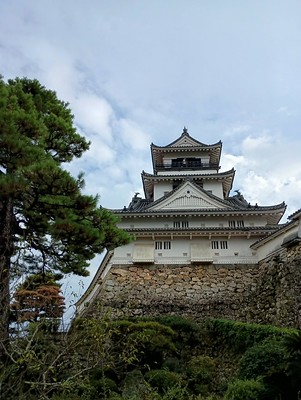Kochi castle
- Built: 1611, Yamauchi Kazutoyo
- Type: Flatland-Mountain
- Japanese: 高知城 (Kouchi-jou)
Kôchi castle, in modern-day Kôchi City, the capital of Kôchi prefecture, was the seat of the Yamauchi clan, lords of Tosa han. It features one of the twelve surviving Edo period tenshu (tower keeps), and one of only two surviving honmaru residential/palatial structures at a Japanese castle, the other being at Kawagoe castle.[1]
History
Kôchi castle is said to be a successor to an earlier fortification built in the 14th century by Southern Court supporter Ôtakasaka Matsuômaru, and known as Ôtakasaka castle.[2]
Edo Period
Chôsokabe Motochika raised a larger, permanent structure in place of this in 1588. He relocated there briefly from his previous base at Okô castle, but soon moved again, to Urado castle to the south. Because the Chôsokabe occupied Kôchi castle for only three years, little is known about the structure or style of this early incarnation of the castle.[2]
After the Chôsokabe found themselves on the losing side of the battle of Sekigahara in 1600, Tosa province was given in fief to Yamauchi Kazutoyo, who initially used Urado as his base, but saw a need for a larger castle town to center his domain, and so kept many of his retainers in Osaka and Edo while they awaited the construction of the new castle, and the larger city of Kôchi, about five miles north of Urado.
Kazutoyo began to rebuild the castle at Kôchi in 1602, enlisting both samurai and commoner/peasant labor, and removing some parts of Urado castle to construct the new castle, based on a plan by his chief building magistrate, Dodo Echizen.[3] The tenshu was completed in 1603, and construction of the complex as a whole was completed in 1611. The castle was heavily damaged by an earthquake in 1707. Just as repairs were being completed, the tenshu and honmaru complex were destroyed by fire in 1712. Another fire in 1727 added further damage to the castle grounds. A major reconstruction project was begun in 1729, with the tenshu and a turret gate being completed in 1747. Construction finished up in 1753.
Modern Period
The Meiji government designated the castle grounds a public park in 1873. The tenshu was then given the name Kanrinkaku, and the honmaru palace Kaitokukan. These were then briefly made into a library and museum in the 1870s to 1890s; those collections and displays were later relocated and reorganized into the Kôchi Prefectural Library, Museum of History, and Kôchi Castle Museum of History.[1]
While the castle was never tested in warfare, an invasion of sorts brought down the castle: termites damaged the tenshu to the verge of collapse in the mid-20th century and it had to be disassembled beginning in 1949. The damaged parts were replaced and reconstruction was completed in 1955.
Layout & Structures
The castle has a typical hirayamajiro layout - the grounds consist of a honmaru located on Otakasakayama (a hill about 42 meters high), a ninomaru to the north on a lower level, and a sannomaru to the east on a slightly lower level. A nishinomaru along with residences was built at the foot of the hill. The castle featured many stone walls with zig-zagging bends and stone-dropping holes at the corners. It also had fences with spears located between the walls, pointing outwards and providing an effective deterrent to any enemy advance. The tenshu has four exterior and five interior levels and is unique among Japanese castles for having a two-level ishigaki stone base. The Kaitokukan ("Hall Of Desire For Virtue") is located next to the tenshu and served as the daimyô residence. It is one of the rare surviving shoin style Edo period daimyô residences. Along with the tenshu and Kaitokukan, the East and West tamon yagura, Kokutetsu-mon, Kurogane-mon, and Roka-mon, are other original structures on the site classified as Important Cultural Properties.
References
- Kodama Kota & Tsuboi Kiyotari, editors Nihon Joukaku Taikei-20 Volumes Tokyo:Shinjimbutsu oraisha, 1981
- Hinago Motoo Nihon No Bijutsu #54:Shiro Tokyo:Shibundo, 1970
- Schmorleitz, Morton S Castles In Japan Tokyo:Charles E Tuttle Company Inc, 1974
